Where Is Mount Everest Located?
The tallest peak in the Himalayas and the world, Mount Everest is one of the most popular destinations for travelers to Tibet and Nepal. A stunning mountain, it has been the challenge of every mountaineer to scale this massive peak and reach the top for over 100 years. While many people travel to Tibet for the unique culture or the spectacular Buddhist temples, almost everyone who visits the region wants to go to Everest.
While only experienced mountaineers can get a permit to climb the mountain, many travelers head for the area in western Tibet to get a view of the mountain from the famous Everest Base Camp (EBC), and to take photos of the mountain to prove they made it there. From pensioners to small children, hundreds of thousands of people have visited this great peak over the years, and thousands make the journey to the roof of the world every year to get a glimpse of the highest point on the planet.
Where Is Mount Everest’s Mountain Range
Mount Everest, which is known in Nepal as Sagarmāthā and in Tibet as Qomolangma, lies in the Mahalangur Himal sub-range of the Himalayan Mountain Range in Asia, which runs from eastern Tibet in Nyingchi prefecture, across the north of Bhutan and Nepal, following the border of Tibet with Bhutan, Nepal, and Indian, and then into northern Pakistan. The range contains many of the highest mountains in the world, and separates the plains on the Indian sub-continent from the high-altitude Tibetan plateau. The easternmost point of the Himalayas is the Tibetan peak of Namcha Barwa, which lies at an elevation of 7,782 meters in Medog County of Nyingchi Prefecture. The area around Namcha Barwa is rarely visited by outsiders, and it stands at the Great Bend of the famous Yarlung Zangbo River, where the river enters the Yarlung Zangbo Grand Canyon, the largest canyon in the world.
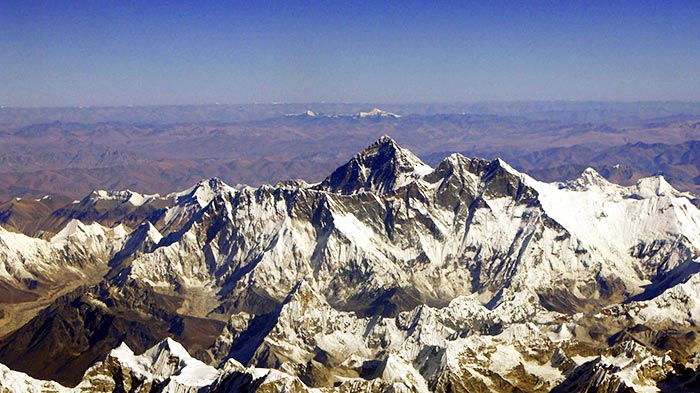 Mount Everest
Mount Everest
The name, “Himalaya” comes from the Indian Sanskrit words meaning “Abode of Snow”. Mount Everest is located in the west of Tibet, on the border with Nepal. The border line actually runs across the peak of the mountain, making it half in Nepal and half in the People’s Republic of China. It was first discovered by western explorers in 1847, when it was seen from several hundred miles away due to the British survey teams not being allowed to enter Nepal and Tibet. However, due to the conditions and distance, the surveyors were not able to estimate the height of the mountain until almost ten years later in 1856.
While the mountain has many names, including those in Nepali and Tibetan, a common local name was not known of, due to the restrictions on travel into Nepal and Tibet, and those in the regions of India to the south of Nepal simply called it Deodungha, which means “Holy Mountain”. So it was that, after a proposal to use the name of the leader of the expedition as the name of the mountain, the British Royal Geographic Society announced its name to be “Everest” in 1865, after Welsh surveyor and officer, Sir George Everest.
Height of Mount Everest
At 8,848 meters, Mount Everest is the highest mountain in the world, although even the height has come under scrutiny over the last century and a half. Originally estimated to be over 9,000 meters, the estimate did not take light refraction into account, and was soon discarded. The first official height registered was of 8,840 meters (29,002 feet), and was maintained until an expedition from India in 1955, which concluded the height to be the current 8,848 meters (29,029 feet).
China later confirmed this, and gave a more accurate reading of 8,848.13 meters in 1975, and another reading done in 1999, using GPS locators on the mountain gave the height as 8,850 meters, with a snow cap of one meter above the rock peak. This has never been recognized outside the United States, and in 2005, after many months of exploration and research, China announced the rock head of the mountain to actually be 8,844.43 meters, with a snowcap of around 3.5 meters. These days, both heights are relevant and approved, although in many places around the world the listed height of the mountain remains as just 8,848 meters.
Weather in Everest Region
The climate in the region around Mount Everest is one of extremes, where the average temperature at the summit rarely gets above freezing. During the spring and summer months, the mountain is racked by westerly winds that can reach speeds of up to 80 kilometers per hour, and the notorious flag cloud is ever present, flying from the peak of the mountain. The Indian monsoon season hits the mountain between June and September and brings wet weather up from the Indian Ocean, often covering the mountain with snowstorms and rain showers. The winter period is also harsh on the mountain, as the southwest monsoon moves in bringing cold, hurricane-force winds to the area. The only periods where it is safe to climb the mountain are in October and May, when the climate is relatively mild, and the weather allows for clearer skies and better visibility.
Where Is Mount Everest in Nepal?
Everest sits on the border between Nepal and Tibet, and from the Nepal side of the mountain, it is a long journey to get to the Base Camp, the closest point tourists are able to get. The same route is used for mountaineers, and from the Base Camp they then move up to the advanced base camps before attempting to scale the mountain.
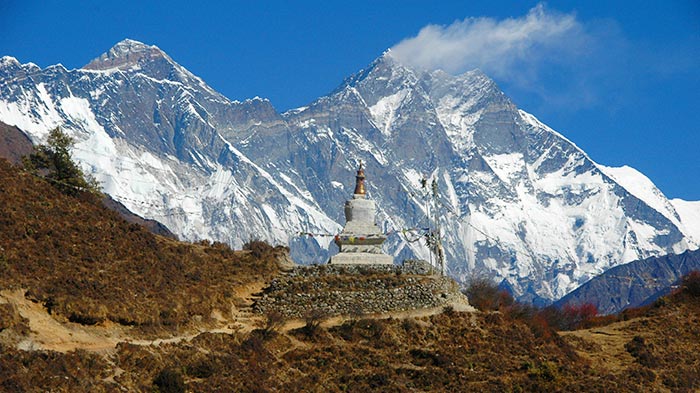 Mount Everest in Nepal
Mount Everest in Nepal
The main issue with getting to Everest on the Nepal side is the hard and sometimes dangerous route that one needs to traverse. All trips start in Kathmandu with a flight to Lukla, in the Khumbu Region of the country. From Lukla it is then a 12-day trek through Namche Bazaar, Tengboche, Lobuche, and Gorak Shep before reaching the Base Camp. The trek entails many steep climbs, and requires at least two days acclimatization at separate points along the route. However, there is no view of the peak from Nepal EBC, as the ridge of the mountain blocks the view. To get the closest view of the peak, one must divert from Gorak Shep to Kala Patthar, a hill nearby, from which you can get a great view of Everest and the surrounding mountains.
As Nepal is open to independent tourist travel, you can trek to EBC alone or with a guide, or you can join a tour group that has porters and yaks to make the trip. Tour groups make it easier to get to the base camp, as you do not have to carry your own luggage, and travel through forests and along valleys to get there, through some of the most spectacular scenery in Nepal. Tour groups can also make the trip a little cheaper than hiking with a personal guide, as the group shares the costs of guides, porters and yaks among them.
Join-in Popular Nepal EBC Trekking Tours
Where Is Mount Everest in Tibet?
On the other side of the border with China is the northern base camp, known as Tibet EBC. The trip to get to EBC in Tibet is much easier than getting to EBC in Nepal, as there is a road that runs right up to the tourist base camp itself. The route to get there starts in Lhasa, in Tibet Autonomous Region, and travels across the Tibetan Plateau, through Gyantse, Shigatse, and Lhatse, where you turn off to Old Tingri before finally reaching the base camp, around 8 kilometers from the famous Rongbuk Monastery. The base camp itself is set a little back from the climber’s base camp, and is the closest tourists can get to the mountain. However, unlike in Nepal, there is a clear view of the peak of Everest from the base camp, and it is a great place to take photos.
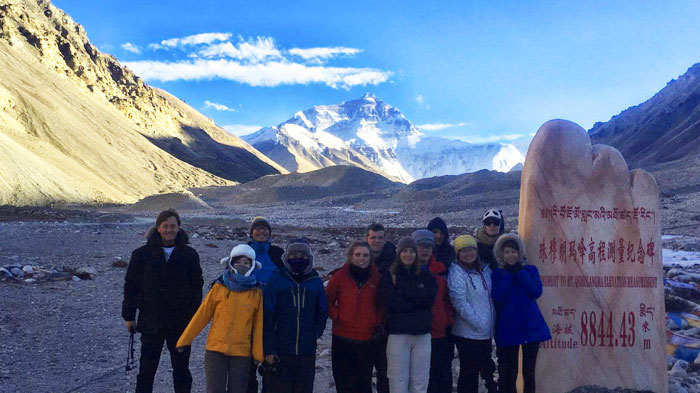 Mount Everest in Tibet
Mount Everest in Tibet
Everest tours in Tibet are the only way to get to the mountain, as individual travelers are not allowed in the region, and all foreign visitors are required to be on a pre-booked tour with a registered tour operator such as Tibet Vista. Tourists must also have a private or shared guide, vehicle and driver, and are required to obtain several permits through the tour operator in order to get into and around Tibet.
Where Is Mount Everest Found in the World?
Mount Everest is a mountain in the Himalayan Mountain Range, which is found in central east Asia, between the Indian sub-continent and the people’s Republic of China. To the north you will find many former Soviet Union countries such as Kazakhstan and finally Russia, and to the south you will come to the Bay of Bengal, between India and Southeast Asia.
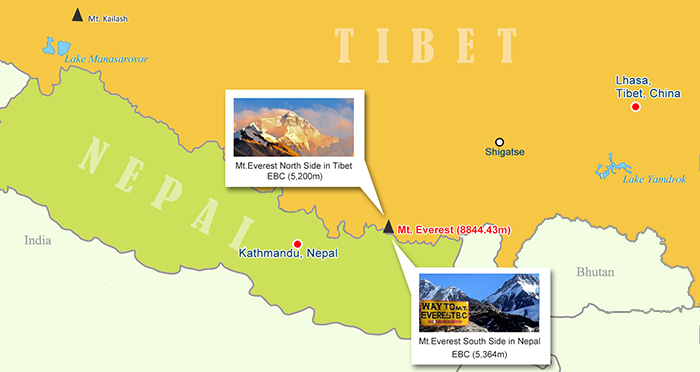 (Simple click to enlarge the map)
(Simple click to enlarge the map)
Mt. Everest Nepal Tibet Map
Everest is easily accessible from Nepal’s neighboring country of India, as well as from Pakistan and Bangladesh. The huge rail network that criss-crosses India is one of the easiest ways to travel to Nepal if you are not flying, and can be a lot cheaper than flights. From Pakistan, one has to cross the Indian regions of Rajasthan and Uttar Pradesh to get into Nepal, and from Bangladesh, the route takes you through Bihar, on the southwestern border with Nepal. From Central India, it is easy to get a train to Lucknow, and then on across the Nepali border a short way, and buses to Kathmandu are available from all the border crossings with India.
When coming from China, one has to book the tour with a tour operator such as Tibet Vista before being allowed to enter the region. One of the best ways to travel to Tibet is by train, and the famous Qinghai Tibet Railway runs through Xining in Qinghai from seven major gateway cities in mainland China, including Shanghai and Beijing. There are also flights to Lhasa, the capital of Tibet, which run from several cities in mainland China. You can also get flights to Lhasa from Kathmandu, to visit EBC on the Tibetan side. Once in Lhasa, travel is by private car that takes you across the plateau to the base camp.
How Mount Everest Was Formed in the Himalayas
The entire Himalayan Mountain Range was formed some 65 million years ago, after the continent of Pangaea split into the continents we know today. Tectonic plates cover the earth like huge scales, and are subject to tremendous subterranean pressure from the lower mantle of the planet. The Indian Plate, during the period from 65 million to 40 million years ago, started to move northwards due to the pressure, and crashed into the Eurasian Plate to the north. With the immense pressure that was behind it, the Indian Plate crumpled at its edge, also crumpling the Eurasian Plate at the same time. The resulting collision forced the mass of rocks along the edge of the Asian plate to ride up, as the Indian Plate began its downward slide under the edge of the Eurasian Plate. Over millions of years, these plates have been moving together slowly with enough force to drive the huge rocks that now form the Himalayas upwards. The force was also enough to crack a huge chunk of the Eurasian Plate and lift it over 4,000 meters towards the sky, which we now know as the Tibetan Plateau.
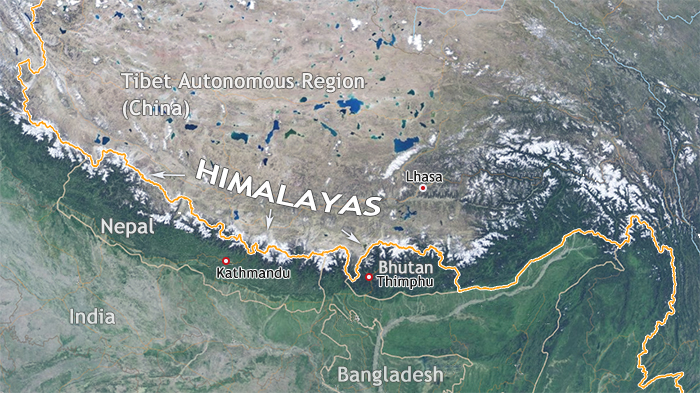 Mount Everest's Formation
Mount Everest's Formation
Scientists state that the Indian Plate is still moving northwards at the rate of around 1.5 centimeters per year, and is slowly sliding further under the Eurasian plate with each movement. It is believed that it is this tectonic activity still going on that has resulted in the difference in height of the peak of Everest between the initial height computations in 1856 and the Indian and Chinese Surveys of the 20th century.
Top 8 Highest Peaks in Himalayas, Including Everest
The Himalayas is home to eight of the top ten highest mountain peaks in the world. As the world’s highest mountain range, this is no surprise, and along with Mount Everest, at 8,848 meters, there are seven other huge peaks that make it to the Top Ten list of the World’s Highest Mountains.
Mount Kanchenjunga - At 8,586 meters, Mount Kanchenjunga is the third highest mountain in the world, coming in behind the infamous K2 in Pakistan. It is located in the western part of Nepal, and was first summated in 1955 by Joe Brown and George Band.
Mount Lhotse - Lhotse is the fourth highest mountain in the world, at 8,511 meters, and sits connected to Everest, also straddling the Tibet Nepal border. The mountain is a dangerous climb for mountaineers due to the rocky slopes, and was not summated until 1956, after Everest had been conquered.
Mount Makalu - Located completely in Nepal, Mount Makalu is a mountain of sharp edges and steep slopes, and peaks at a stunning 8,463 meters. First climbed successfully in 1955, this pyramid-like mountain also plays host to some great trekking routes.
Mount Cho Oyu - Located in Nepal, Cho Oyu is the sixth highest mountain at 8,201 meters, and has been named as one of the easiest mountains to climb since its summit in 1954. Often used as a training climb for budding Everest mountaineers, Cho Oyu is known in Tibetan as the “Turquoise Goddess”.
Mount Dhaulagiri - The seventh highest mountain in the world, Dhaulagiri’s peak sits at an elevation of 8,167 meters, and is located in north-central Nepal. The name, in Nepali, means “White Mountain”, and it is a popular place for both trekkers and climbers since it was conquered in 1960.
Mount Manaslu - Located completely in Nepal, and with an elevation at its peak of 8,163 meters, Manaslu is the eighth highest mountain, and is covered from the top to bottom, including a huge area around the base, with hard, thick ice. Known locally as the “mountain of the Spirit”, it was first breached in 1956 by a Japanese climber.
Mount Annapurna - Famous for the huge number of trekking routes that circle this mountain, Annapurna is the tenth highest mountain at 8,091 meters. Located in central Nepal, Annapurna peak is the most dangerous climb in the world, and was first conquered in 1950. The name is Sanskrit for “Goddess of the Harvests”, and is inside the Annapurna conservation area, the largets of such in Nepal.
More Mount Everest Base Camp Travel Guide
 Mt.Everest Fact
Mt.Everest Fact- Everest Base Camp Nepal vs Everest Base Camp Tibet
- Mount Everest History and Its Famous Explorers
- The Difference of Mt.Everest in Nepal and Tibet
- Kathmandu to EBC Distance: how far and how to get to EBC in Nepal and Tibet from Kathmandu
- How Many Base Camps on Everest in Both Sides of Tibet and Nepal
 Everest Base Camp Tour Guide
Everest Base Camp Tour Guide- When is the Best Time to Visit Tibet Everest Base Camp in 2024
- When is the Best Time to Enjoy EBC Trek in Nepal
- The Best Hotel at Everest Base Camp in Tibetan Side
- Guide to Tibet Everest Base Camp Tour in Winter
- How to Get to Everest Base Camp (EBC) from Nepal?
- How to Get to Mount Everest Base Camp from Lhasa
- What Documents Do I Need for Everest Base Camp Tour in Tibet and Nepal?
 Everest Trekking Guide
Everest Trekking Guide- What to Pack for Everest Base Camp Trek
- Tingri to Everest Base Camp Trekking
- Everest Trek: Trekking Routes along The Gama Valley
- Everest Base Camp Trekking Maps in Tibet
- Ultimate Packing List for Everest Base Camp Trek in Tibet
- Best Trek in Nepal: Everest Base Camp Trek vs. Annapurna Circuit Trek
- Top 2 EBC Trekking Routes in Tibet
- EBC Trek in Tibet vs. EBC Trek in Nepal

Recommended Everest Base Camp Tour Packages
-
 7 Days Lhasa to Kathmandu Overland Small Group Tour: Traverse from the North Side to the South Side of Mt.Everest for the Best of the Himalayas
7 Days Lhasa to Kathmandu Overland Small Group Tour: Traverse from the North Side to the South Side of Mt.Everest for the Best of the HimalayasTour Route: Lhasa - Gyantse - Shigatse - Everest Base Camp - Gyirong - Kathmandu
From USD979 p.p
-
 8 Days Lhasa to Everest Base Camp Small Group Tour: Marvel at Mt.Everest Real Close from 4 Different Viewing Platforms
8 Days Lhasa to Everest Base Camp Small Group Tour: Marvel at Mt.Everest Real Close from 4 Different Viewing PlatformsTour Route:Lhasa - Gyantse - Shigatse - Everest Base Camp - Shigatse - Lhasa
From USD939 p.p
-
 10 Days Lhasa to Everest Base Camp and Namtso Lake Small Group Tour
10 Days Lhasa to Everest Base Camp and Namtso Lake Small Group TourTour Route:Lhasa - Gyantse - Shigatse - EBC - Shigatse - Lhasa - Namtso Lake - Damxung - Lhasa
From USD1289 p.p
-
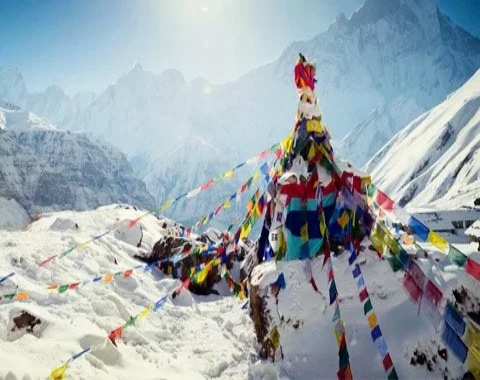 17 Days Nepal Everest Base Camp Trek Tour
17 Days Nepal Everest Base Camp Trek TourTour Route:Kathmandu - Phakding-Namche Bazaar-Tengboche- Dingboche- Lobuche-Gorakshep- Everest base camp-Kathmandu


.jpg)


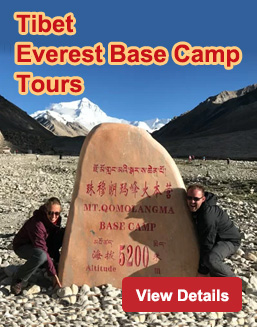

0 Comment ON "Where Is Mount Everest Located?"